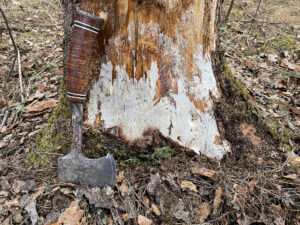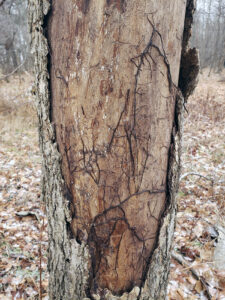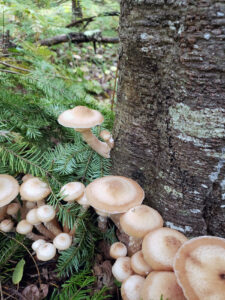
Bark has been removed from a declining white spruce to show the white mycelial mat of Armillaria under the bark. / Photo Credit: Linda Williams, Wisconsin DNR
By Linda Williams, DNR Forest Health Specialist
Linda.Williams@wisconsin.gov or 920-360-0665
Armillaria is a root-rot pathogen that usually lives quietly under the soil. But when trees experience stress, the fungus can attack and colonize the roots of the stressed tree.
Armillaria can infect many different species of trees, and trees of any age or size, but the result for the tree is usually a slow decline and eventual death. Stressors can include drought and flooding, defoliation from insects or diseases or physical damage such as when roots are severed.

Bark has been removed from a long-dead tree, exposing black shoestring rhizomorphs of armillaria. / Photo Credit: Linda Williams, Wisconsin DNR
How do you know if Armillaria is a problem for your trees? Trees that are recently dead or nearly dead can be examined by removing some of the bark near the base of the tree to look for Armillaria’s white mycelial fans between the bark and the wood.
On trees that have been dead for longer periods, removal of the bark may reveal the black shoestring rhizomorphs, which resemble small roots. These rhizomorphs are where Armillaria gets its other common name: shoestring root rot. The fungus can also produce tan mushrooms, commonly called honey mushrooms.
Trees that are infected by the fungus, which causes a white stringy rot in the wood, can suddenly break over when the structure of the roots is compromised. Examination of the broken roots will show the white mycelial fans under the bark of the roots, or shoestring rhizomorphs growing around the failed roots.
How does the fungus detect stress in a tree so that it knows it can infect the roots? When trees are under stress, they use up the stored starches in their roots and must resort to making glucose. This change can be detected by the fungus. Additionally, the amino acid asparagine increases within the tree during times of stress, and this can be detected by the fungus.
Other physiological changes can occur in a tree when it is under stress, but research seems to show that it is the presence of glucose and asparagine in the roots that stimulates Armillaria to grow and invade.
What can you do about Armillaria? Unfortunately, once you see decline symptoms in the aboveground parts of your tree and realize Armillaria is attacking, it’s typically too late to save that tree. Maintaining tree health can prevent infection. Proper management of forest stands can help keep trees as healthy as possible. Yard trees can be watered during dry periods to eliminate that stress. Avoid using fertilizers, weed-and-feeds or herbicides near yard trees to minimize stress.

Honey mushrooms grow at the base of a declining balsam fir that had been stressed by multiple years of defoliation from spruce budworm. / Photo Credit: Linda Williams, Wisconsin DNR
Visit the Wisconsin DNR webpage on Armillaria and its fact sheet on Armillaria for additional information and pictures.
